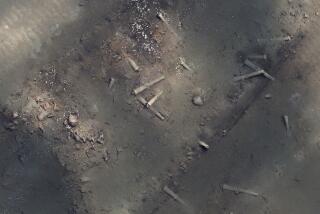Swords, Jewels, Coins Date Back to Biblical Times : Israelis Salvage Wealth of Ancient Ships
- Share via
JERUSALEM — Israeli divers have salvaged Canaanite swords, bronze jewelry and sacks of Syrian coins from the remains of ancient ships, the oldest of which may have been sunk by pirates in biblical times, the Israel Museum said.
The finds constitute “one of the largest treasures ever found underwater, not only in quantity but in historical value,” said Kurt Raveh, a diver from the government’s Department of Antiquities.
Raveh said the trove was discovered in 1983 after a storm shifted centuries-old silt accumulations south of the port city of Haifa about 150 yards offshore. The discovery was kept secret until it was ready to be displayed, he said, to avert an invasion of fishermen and private treasure hunters.
The ships were either wrecked in storms or “robbed by pirates who took the gold and silver and sank the ships with the rest of the cargo,” the Dutch-born Raveh said. Few traces of the ships remain, he added.
Archeologist Osnat Misch-Brandl said the earliest ship--carrying lead, tin and copper ingots--was sunk in the 14th Century BC, about the time Moses was leading the Israelites out of Egypt.
Another ship, sunk more than 1,000 years later, yielded bronze jewelry and pieces of life-size statues, including the broken-off fold of a dress inlaid with silver in an intricate floral pattern.
A third ship carried hundreds of thousands of coins weighing half a ton that were minted as late as 1404 in Syria. The ship was on its way to Egypt with a cargo of candlesticks and materials for a public building, Misch-Brandl said.
Raveh said the coastline has a dangerous underwater reef and few safe harbors. That area, he said, was a haven for pirates and not a normal sailing place for ships that plied the eastern Mediterranean.
As many as 100 ships may be resting in the shallow water off the Israeli coast, Raveh said, adding, “We have found older ships before, but none with such a vast cargo.”
The cargoes now on display were found about nine feet underwater in an area of about 36 square yards, he said. A storm exposed the hoard of coins, “which is one of the largest in the world as far as we know,” Raveh said.
Raveh said bracelets decorated with peacock-eye designs, jewelers’ tools, arrowheads and a few 2nd-Century BC coins were found in one earthen jar that apparently had been protected by silt, leaving its contents beautifully preserved.
Misch-Brandl said the jewelry and other items in the jar, which weighed about 220 pounds, were probably on their way to be melted down for recycling. It is unusual to find bronze artifacts because of the high cost of the metal in that period, she said. “Nothing was thrown away. Metal was always reused.”
More to Read
Sign up for Essential California
The most important California stories and recommendations in your inbox every morning.
You may occasionally receive promotional content from the Los Angeles Times.












